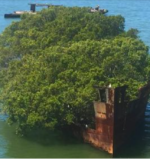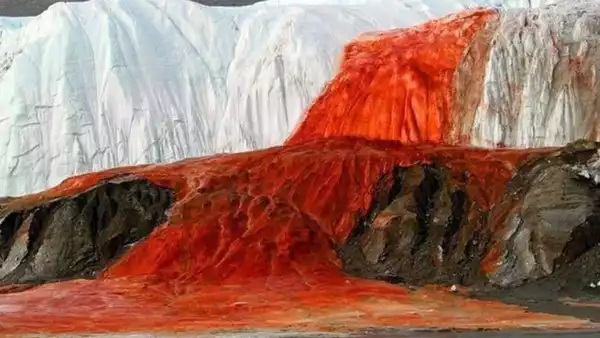While the SS Ayrfield was once a proud steam cargo ship, even used in World War II, its decaying shipwreck now stands as the famous Floating Forest of Homebush Bay.

Homebush Bay is located on the south bank of the Parramatta River, in Sydney, Australia. The Bay and its surrounding became a huge industrial area in the 20th century, which resulted in massive land reclamation. As the industrial activities had scaled down, the Bay became a dumping ground for waste, broken-up ships, and toxic industrial waste.
During the industrial golden age of Homebush Bay, Union Carbide manufactured chemicals there, including Agent Orange, which became well known during the Vietnam war. Not surprisingly, the Bay became heavily contaminated with dioxin and other chemicals during those times. So much so, that at the time, a fishing ban had to be introduced in most of Sydney Harbor.

However, thanks to the initiatives to rehabilitate the area that began in the 1980s, and the economic boom brought on by the 2000 Olympic games in Sydney, Homebush Bay is now a popular commercial and residential area in the city. Parks have been established, and the initiatives helped restore the mangrove wetlands and saltmarshes which existed around the bay before its industrial era.

Only a number of rusting ship hulls remain as a reminder of the bay’s past. One of these abandoned vessels is the shipwreck of the SS Ayrfield, which has taken on a new role by becoming one of the main attractions of Homebush Bay as the ‘Floating Forest’.
The story of the Ayrfield goes back to 1911. The 1140-ton steel ship was built by the Greenock and Grangemouth Dockyard Co. under the name Corrimal, and was used to transport goods between Newcastle and Sydney until being reassigned to transport supplies to allied troops in the Pacific region during World War II.

Then in 1951, the ship was sold to R. W. Miller, and converted into a collier, and renamed to Ayrfield. In the next 21 years it transported coal between Newcastle and Miller’s terminal in Blackwattle Bay. After the vessel got decommissioned in 1972, it was sent to Homebush Bay. The plan was to dismantle the Ayrfield right at the bay, which also served as a ship-breaking yard at the time. The work had come to a halt, though, and the skeleton of the ship was left at the bay rusting away.
It stands abandoned there ever since, among other old shipwrecks. But what really makes the Ayrfield stand out is the way nature has enveloped it with hardy mangrove trees. The bursting trees growing over its hull provide a dramatic contrast to the bay’s now peaceful environment.

The rusted wreck overtaken by the elements, has now become part of the Homebush seascape. It is a popular destination for tourists, but it’s also a favorite among photographers – even a Shipwreck Lookout was established.
Most importantly, though, the 111-year-old Ayrfield stands as a small piece of history, one that will hopefully continue to amaze people for a long time.








 Photographer Finds Locations Of 1960s Postcards To See How They Look Today, And The Difference Is Unbelievable
Photographer Finds Locations Of 1960s Postcards To See How They Look Today, And The Difference Is Unbelievable  Hij zet 3 IKEA kastjes tegen elkaar aan en maakt dit voor zijn vrouw…Wat een gaaf resultaat!!
Hij zet 3 IKEA kastjes tegen elkaar aan en maakt dit voor zijn vrouw…Wat een gaaf resultaat!!  Scientists Discover 512-Year-Old Shark, Which Would Be The Oldest Living Vertebrate On The Planet
Scientists Discover 512-Year-Old Shark, Which Would Be The Oldest Living Vertebrate On The Planet  Hus til salg er kun 22 kvadratmeter – men vent til du ser det indvendigt
Hus til salg er kun 22 kvadratmeter – men vent til du ser det indvendigt  Superknepet – så blir snuskiga ugnsformen som ny igen!
Superknepet – så blir snuskiga ugnsformen som ny igen!  Meteorite That Recently Fell in Somalia Turns Out to Contain Two Minerals Never Before Seen on Earth
Meteorite That Recently Fell in Somalia Turns Out to Contain Two Minerals Never Before Seen on Earth  Nearly Frozen Waves Captured On Camera By Nantucket Photographer
Nearly Frozen Waves Captured On Camera By Nantucket Photographer  It’s Official: Astronomers Have Discovered another Earth
It’s Official: Astronomers Have Discovered another Earth 
zq618o
4o1loz
g2mcup
7fomx1
v7xzli